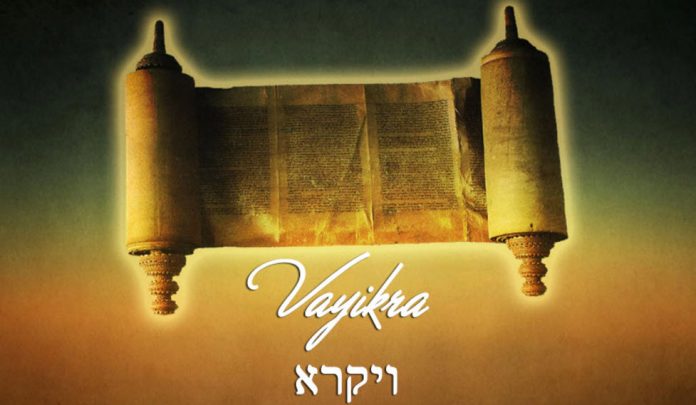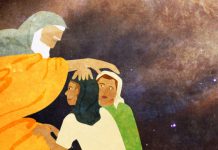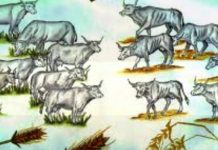How Animal Offerings Help Us Tap Into the Divine Presence
DATELINE: June 1967
PLACE: Jerusalem, the Western Wall
The Battle of Jerusalem was very bloody. There was no air cover to prevent the bombing of holy sites, and there were many casualties. Finally, the soldiers reached the Wall. No Jew had been there from 1948 until that day in 1967. The emotions soared. What a bloody battle they had survived! What a holy place they were in! All the battle-crusted soldiers broke down in tears and prayer. Only Uri and Yuval could not figure out what the crying was all about.
Suddenly, Yuval also burst into tears. “What are you crying about?” Uri asked. “After all, it’s only a wall of stone. Just because it has historical significance doesn’t mean you have to get all choked up about it! Have you ever heard of anyone crying at the Acropolis or the Great Wall of China?”
Between sobs, Yuval replied, “I’m crying over the fact that I’m not crying! I don’t know enough about my heritage to understand what there is to cry about at this wall!”
Every year on the 9th day of the Jewish month of Av, we take off our shoes and sit on the floor to cry over the destruction of the Holy Temple almost 2,000 years ago. Someone who doesn’t know what there is to cry about, should cry over that fact itself. Napoleon reportedly said that a nation who can cry over their Temple for 2,000 years, will exist forever and will eventually rebuild their Temple.
THE TEMPLE AND THE DIVINE PRESENCE
Tradition teaches that when the Temple was destroyed, the Divine Presence departed. A taste of that holiness, however, still remains at the Western Wall.
Analogy: Spill the perfume out of its jar and smell the jar. It still smells good because a few remaining drops of perfume permeate the jar. So too, we can still perceive (if we make the effort) the remains of the Holiness of the Temple at the site of the Western Wall.
In addition, all synagogues and places of Torah study are considered to be miniature Temples where one can feel the Divine Presence there as well.
INTRODUCTION TO BOOK OF LEVITICUS
In the pristine state of the world, before the sin of Adam, the Divine Presence was manifested openly throughout the universe. Adam felt God’s presence in the Garden of Eden, and when God asked him “Where are you?” Adam replied, “I heard your voice – i.e. I felt your presence – and was ashamed.”
However, this state cannot remain when people disregard the will of the Creator.
“I’m in seventh heaven, Bob!”
This common expression is taken from the Talmud that states there are 7 levels of heaven that God ascends. When Adam sinned, He removed Himself one level. When Cain killed Abel, God removed to the second. In the generation of the Flood, God went up further still … until He reached the “Seventh Heaven.”
Then, when Abraham followed his Creator, he brought the Divine Presence back down one level. Isaac another, and Jacob a third. Moses, 7 generations from Abraham, finally returned the Divine Presence fully to this world. That was at Sinai when the heavens spread out on the mountain, and God came down upon them.
But unfortunately, when the people sinned with the Golden Calf, the Divine Presence said once more goodbye!
How do you keep God here with us, so to speak? That is the theme of the book of Leviticus, as we shall see.
The first half of Leviticus discusses how the Divine Presence was maintained in Temple times through the sacrificial service. The second half, which can be summarized by the name of Parshat Kedoshim – “You shall be holy” – deals with how to keep the Divine Presence in our midst even when there is no Temple. We achieve this by sanctifying our physical aspects – food, speech and relationships.
ANIMAL OFFERINGS
People today have a hard time comprehending the concept of animal offerings. They certainly don’t want to restore them, and some have actually censored out any mention of doing so from prayer books.
Yet there must be a good reason why these offerings comprise such a large part of the Torah. We will therefore try to understand their symbolic meaning, basing much of our explanation on the writings of Rabbi Samson Raphael Hirsch (19th century Germany).
When Abraham was ready to offering his son Isaac (Genesis 22), God’s angel appeared and told him to stop. The Torah then says that Abraham found a ram in a thorn bush and offered it “instead of his son.” How can a ram – that doesn’t even belong to Abraham – be a substitute for his beloved son? (“Please accept this bobby pin I found on the floor as a token of my appreciation for the million dollars you gave me!”) The surprising thing is that Abraham receives God’s blessing only after sacrificing the ram. Who cares about the ram anyway!?
The commentaries explain that what Abraham did to the ram, he felt in his heart as if he was doing it to his son. He had to experience the pain of killing Isaac, the struggle of asking “why?” and to overcome his emotional stress to fulfill the will of his Creator.
Thus by offering the ram instead of his son, Abraham received God’s blessing.
Similarly, when a Jew would bring an offering to the Temple, he had to feel it was his own flesh and blood that really deserved to be offered, and God should accept this animal as a meager substitute for himself.
This realization by itself had the power to change a person’s attitude about life and his relationship with the Almighty.
The animal’s slaughter teaches that I have to symbolically slaughter the animal side of me. The blood which symbolizes life is then sprinkled on the side of the altar, which symbolizes the service of the Almighty. Parts of the animal are then burned on the altar, Rabbi Hirsch explains, to symbolize bringing “the fire of Godliness into the world.”
However, this only worked when the Jewish people were living according to God’s will. At the time of the Temple’s destruction, many Jews were paying lip service with their offerings. Thus God told the prophet: “Do I need the fat of their rams?” – i.e. if an offering is insincere, then it is only a waste of the poor animal.
WAKE-UP CALL
The Parsha begins with a wake-up call: “And He called to Moses” (Lev. 1:1). This was the same voice Moses heard at Sinai and in solitude at the Burning Bush. Whether it is in front of an audience of millions, or one, it makes no difference to God. The voice, however, didn’t escape the confines of the Tabernacle, and was unheard by the people outside. God always broadcasts on the same frequency, you simply have to adjust your receiver to tune into what He is telling you!
ADAM IN THE GARDEN OF EDEN
Our Parsha speaks of “a person who will bring a offering to the Lord” (Lev. 1:2). The Hebrew term used for “person” here is not the common “ish,” but rather “adam.” The Sages say this is a hint to Adam in the Garden of Eden. Just like Adam could not bring a stolen article as a offering, because the entire world belonged to him, so too an offering must be brought only from one’s own possessions.
It is common today to hear of people who cheat in business and then give a big donation to charity. The Sages use the following analogy: The government tax collector was beaten and robbed by a certain individual. When the defendant was asked for testimony in his favor, he called the tax collector to the stand who described in detail how he abused him. The spectators all gasped, “Woe is to him that his defense witness turns into his prosecutor.” The same thing will occur in heaven when the charity one gives will stand and proclaim its stolen origins.
You can’t transgress and hope to do a Mitzvah at the same time. It just won’t work.
Furthermore, all offerings must be without blemish. The first person to conceive of the idea of symbolically giving something to God was Cain. But he brought the worst of his bounty (after all, the Almighty doesn’t really eat it anyway!) Abel, on the other hand, understood that when you bring to God, you bring the best, so he brought his best lambs. God sent down His fire to consume Abel’s offering and ignored Cain’s.
The Torah says that the offerings produce “a beautiful fragrance for God.”
Question: Does God really smell the roasting meat?
Answer: The sense of smell is unique. Eyesight and hearing need no physical contact and are therefore more spiritual senses. Touch and taste require contact and are more physical. Smell does require contact, but only minute particles enter the nose. So the minute feelings of the Jew to come close to God through the offering is sensed by God, like the sense of smell. (Rabbi Hirsch)
THE CATEGORIES OF OFFERINGS
The Parsha describes four categories of offerings:
- Voluntary Burnt Offering
- Peace Offering
- Sin Offering
- Guilt Offering
The first category is Olah, the Voluntary Burnt Offering. Although not required, these offerings atoned for neglecting to perform positive commandments, and for harmful thoughts or intentions.
The animal was burned totally, except for its skin which was given to the Kohen.
The type of offering would depend on the financial ability of the donor. He had 3 choices:
(1) Domestic Animals: Cows, goats, or sheep. The freedom that wild animals enjoy contrasts the subordination one must feel in the presence of the Almighty.
These animals represented different relationships with God. The ox that pulls the plow represents a dedication to be an active worker in God’s field. The lamb that trusts its shepherd represents putting all one’s trust in the Almighty. The goat is known for its trait of stubbornness, symbolizing he who stubbornly rejects that which draws him away from God.
Jewish history is the tale of the martyrdom of a nation refusing to compromise their faith. In this manner the Jew would symbolically “kill the animal inside” himself, and burn the fire of Godliness in the world.
(2) Birds: The only 2 species permitted are doves and turtledoves. The dove is only brought in its early state of development, and the turtledove only in it’s latter state. (Birds that shed their feathers are considered to be in the middle stage, and therefore both species would be disqualified.)
(3) Grain: The offering was made from wheat flour (or barley on certain occasions) and baked into matzah or bread.
THE PROCEDURE
For cows, goats and sheep, the Kohen would slaughter the animal in the courtyard of the sanctuary. He would then sprinkle its blood on the side of the altar (at the bottom). He would then skin it and divide the meat into parcels. Each parcel (including the stomach and intestines after being washed well) was salted and then put individually onto the altar fire and totally consumed.
For bird offering, the Kohen would use his long fingernail to divide the head from the body at the back of the neck. He would then remove the crop and throw it down at the side of the altar (where it was miraculously swallowed up by the earth). He would then squeeze out its blood against the side of the altar, and then tear apart its wings (but not dividing them totally). The entire bird was then spread out with all of its feathers and burned on the altar.
This is called “a beautiful fragrance before God.”
Question: Have you ever smelled burning feathers? Are they really so aromatic?!
Answer: The Bible often uses the analogy of a bird to describe someone who is suffering pain. When King David ran from his enemies, he likened himself to a bird trying to avoid all the traps and pitfalls set for it. The poor man who cannot afford a bull or lamb brings the bird. His life is full of struggling and suffering. Says the Torah, he can also come close to his Creator with a bird offering. Even if they flick off your head, tear you apart, and squeeze out all your blood. With every last drop of blood you can also burn the fire of Godliness in the world. This means that even in a state of suffering one can still draw close to God.
Question: Why don’t we remove the feathers before burning the bird to avoid the terrible smell of burning feathers?
Answer: The Talmud says that the average person sees the rich person’s bull or lamb taking up so much space on the altar, while his little bird is so tiny. This can cause him to be embarrassed. To alleviate this shame, we spread out his bird with all its regal plumage. The fact that a person is spared embarrassment is what causes the “beautiful fragrance before God!”
For grain offerings, the Kohen would combine fine flour, olive oil, and the spice frankincense. A 3-finger scoop of flour-and-oil was separated by the Kohen and burned on the altar. The remains were baked into bread and eaten by the Kohen. Grain offerings were prepared using an oven, a shallow pan, or a deeper pan. The different types were distinguished by the amount of oil used.
The meal offering symbolizes dedicating one’s physical existence to the Almighty – from the necessities of flour to make bread to the luxuries of the oil. The cooking utensils employed in baking the bread also bear out basic relationships – the various pans had different ratios of oil to flour to symbolize the extent one’s luxuries and necessities played their role.
PEACE OFFERINGS
A person who hadn’t sinned, but rather has a positive feeling and wants to relate to the Almighty from that good feeling, would bring a Peace Offering. The offering consists of a male or female cow or sheep. The fats are burned on the altar, parts are given to the Kohen, and the remainder is eaten by the donor. This way, everyone is happy to get their share, adding a measure of peace to the world.
SIN OFFERINGS
Only severe sins – done unintentionally – are atoned with a sin offering, a female sheep or goat. Unintentionally means that a person was not aware of the prohibition.
If Jewish leaders made a mistake and caused the people to sin unintentionally, they have to bring a special offering. This applies to the High Priest, king, and Sanhedrin (Supreme Court).
THE SLIDING (GRADUATED) SIN OFFERING
For 3 transgressions, the donor has an option based on financial ability:
(1) One who denied knowledge when requested to testify on an event he witnessed, and took an oath to that effect. He now wishes to atone for that act.
(2) One who mistakenly entered the sanctuary or ate offerings when in the state of spiritual impurity, and later discovered his mistake.
(3) One who out of forgetfulness broke an oath, and then discovered his mistake.
For a wealthier person, the offering is a female lamb or goat. An average person would bring two birds. And a poor person would bring a grain offering.
The common denominator of these 3 transgressions is a denial of knowledge – whether testimony, one’s spiritual state, or an oath. The Torah considers this so severe that an immediate atonement is required. He cannot wait until he can afford the regular sin offering as with other transgressions, but must atone right away even if he will bring only birds or meal. (Rabbi Hirsch)
THE GUILT OFFERING
For certain transgressions, there is a requirement to bring an additional offering called a Guilt Offering:
(1) One who unintentionally derived benefit from the Temple and any of its vessels or edibles.
(2) One who stole money or denied receiving a loan or a security, and took a false oath (intentionally) to that effect. When admitting guilt, the person must pay back the money they stole, plus add on a one-fifth fine, and bring a Guilt Offering.
(3) One who isn’t sure if a transgression was performed at all. Example: Kosher and non-kosher fat was before him, and he ate one of them without knowing which one.
The Guilt Offering atones until a person can establish that he actually did sin, in which case he then brings the regular Sin Offering (for severe transgressions).
The entire book of Leviticus teaches us how to keep the Almighty with us. The offerings are a primary symbol of this special relationship.
credit to aish.com














